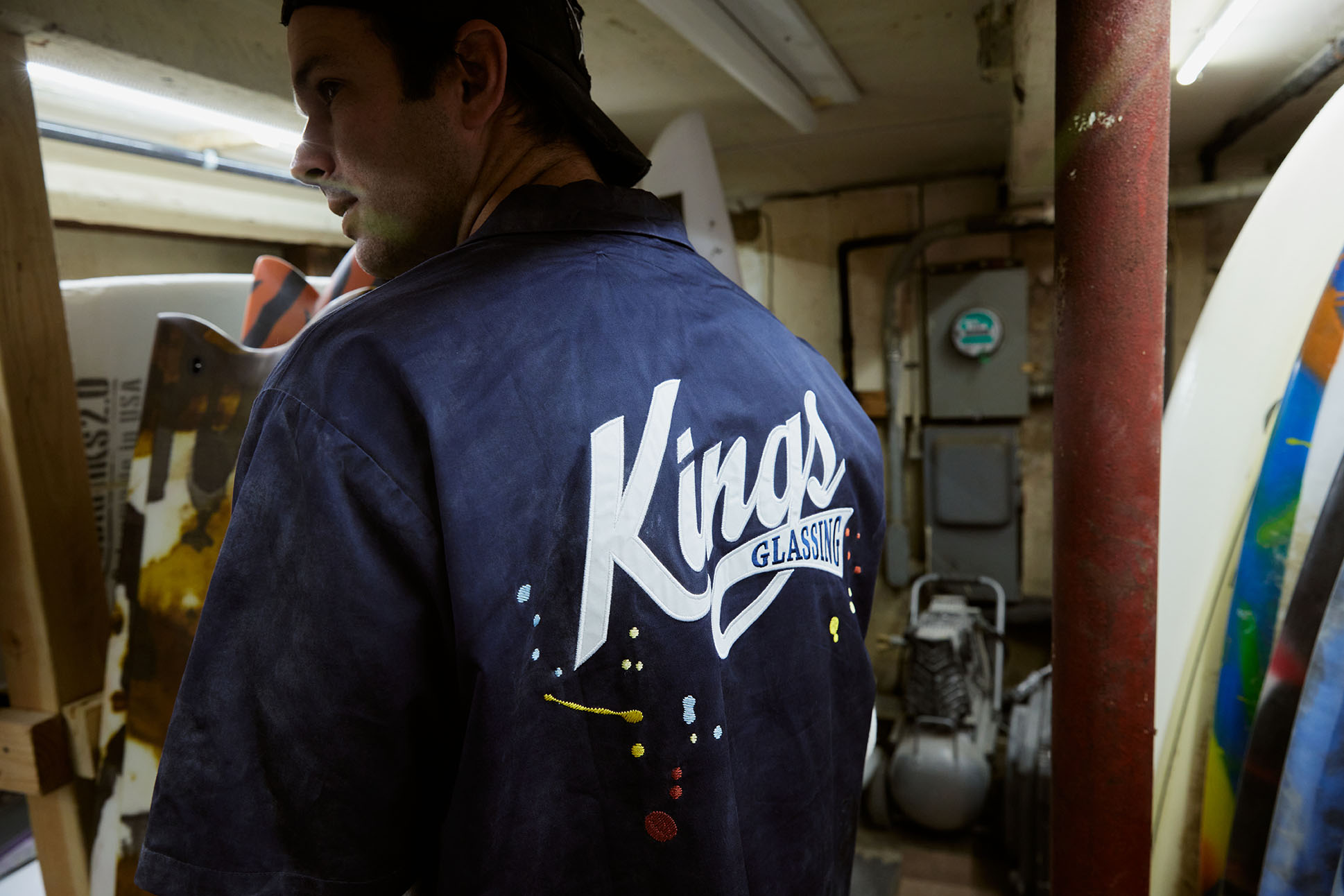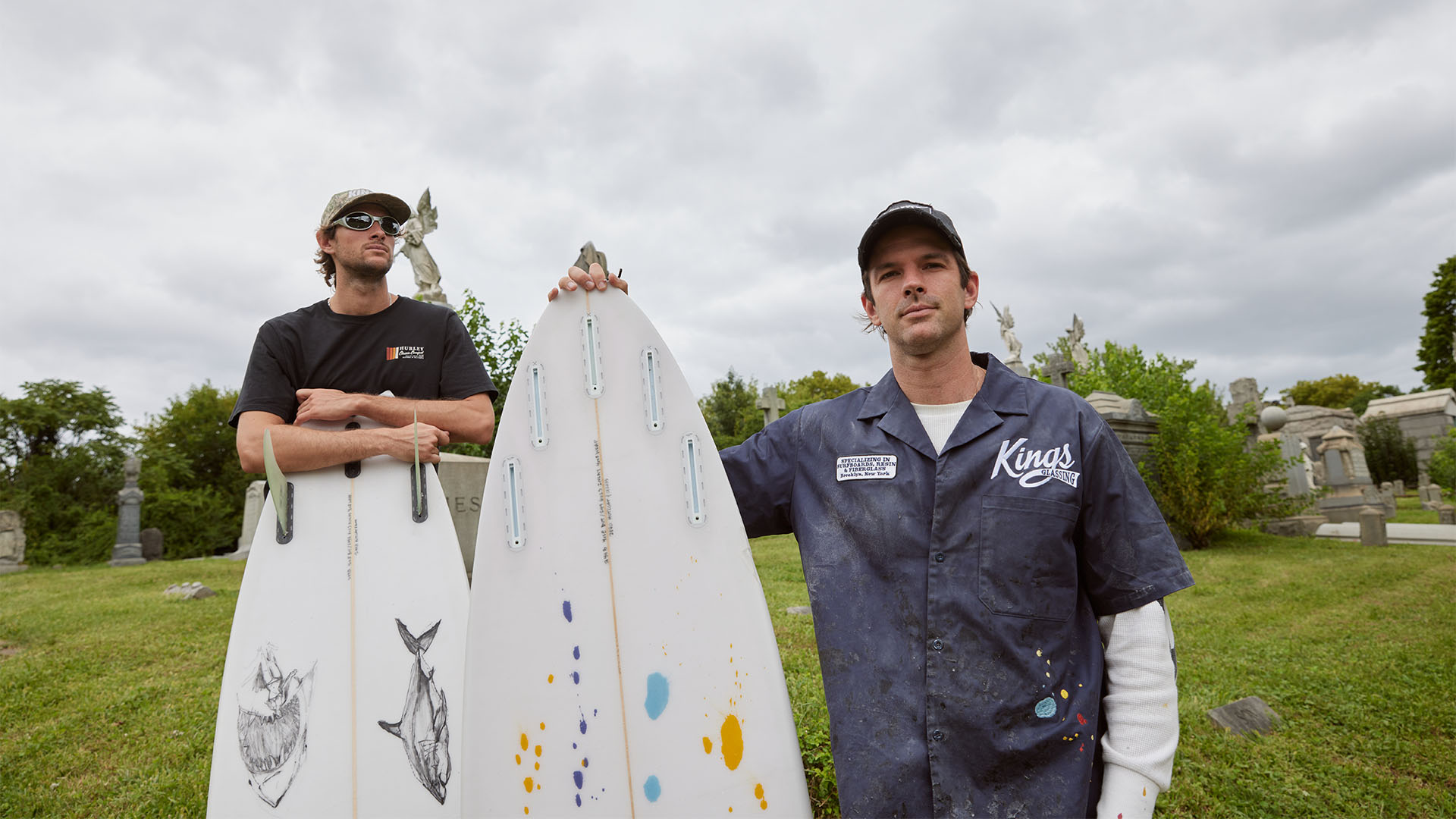Aaron and Drew Austin of Kings Surfboard Glassing, who grew up surfing on Maui, imbue their process with an artisanal approach.
Images by Desmond Centro
Before a surfboard becomes an object of aesthetic adoration or athletic envy — say, a finely shaped fish with a curved swallowtail and glossy aquamarine coloring — it appears unremarkable, as a white, buoyant polyurethane foam blank. A five-foot plus tabula rasa waiting for craftspeople to leave their mark which — with enough time, skill, patience, errors, and persistence — becomes their legible signature to the surfing world at large.
Eleven miles from the closest surf break, along an urban stretch of road and across from a sprawling graveyard, roughly one dozen of these untouched blanks are stored in the basement of Kings Surfboard Glassing in Queens, New York, where two brothers, Aaron and Drew Austin, shape, laminate, and hot coat surfboards each day, leaving their own imprint on board making while bringing Hawai‘i’s high standards to the East Coast.
Their venture started as a hobby in 2019, then ramped up during the pandemic in 2021 when work for their day jobs slowed (Aaron, 38, worked in commercial photography and Drew, 27, was a recent college graduate working in tech), and a general interest in surfing boomed.
Both had grown up surfing on Maui. In 2000, a family vacation to the island prompted their parents to uproot their lives in Scottsdale, Arizona, and undergo a move so abrupt — only their mother returned to pack up everyone’s belongings — “Aaron’s friends thought he had died,” Drew remembers. Aaron was 13, their sister Natalie was 11, Drew was barely 2.
The Austins lived in Nāpili, just north of Lahaina, and their neighbors were the Payne family. Aaron, still a novice surfer, would go out in double overhead conditions with Dusty Payne, a rising local surf star, and “get absolutely destroyed.” Drew started surfing soon after he was able to swim.

As much as they loved the sport, surfboard making wasn’t their plan. In 2005, Aaron studied marketing at Hawai‘i Pacific University on O‘ahu and, in 2011, studio photography at Spéos, a photography school in Paris, which eventually led to digital production work. In 2016, Drew moved to Santa Barbara and majored in computer science at Westmont College. When they both relocated to New York City — Aaron in 2013, Drew in 2021 — they would surf at Rockaway Beach, Queens, on weekends or whenever an unmissable hurricane swell would pass through.
Aaron became more interested in board making in part “because I had to in order to do better in the waves and surf year-round.” Unlike Hawai‘i, swell conditions are more inconsistent on the East Coast and even the thickness of a wetsuit changes the board required. Aaron started shadowing New York and Hawai‘i-based shapers and laminators who showed him the basics. He found a studio to start the business in earnest in 2021. Drew, who was then bouncing between New York and California, asked if he could start sanding.
Around the same time, Chris Gentile, owner and founder of Pilgrim Surf and Supply in Williamsburg, was toying with the idea of starting a surfboard shaping residency where luminary makers from around the world — shapers like Ventura-dwelling Rachel Lord and laminators like Biarritz-based Fantastic Acid — could interact with customers and build them custom boards. Only he was missing a crucial element: city-based glassers and sanders. While others were in close proximity in New Jersey, Long Island, and Rhode Island, Kings had cornered a local niche which impressed Gentile and made his residency concept more logistically feasible.
“If you need a clear, sanded board there are a variety of shops in our vicinity that are much cheaper,” says Gentile. Surfers come to Pilgrim for the singular caliber of the surfboards, and Gentile turns to makers like Kings Glassing “because they really specialize in color work and an artisanal level of craftsmanship.”
A good board is the basis of the surf community.
Drew Austin

The brothers have discrete roles: Drew shapes and sands; Aaron laminates and hot coats. Unlike most lamination shops, Kings double sands each board: the first time after the hot coat — a clear coat of resin that seals in the lamination or colorwork that’s been applied over fiberglass cloth that’s been fitted to the freshly shaped blank — and the second time after a thinner gloss is applied before it’s polished. It’s a laborious, time-consuming approach but worth the effort. “It improves the life of the board,” Aaron explains.
The entire craft is learned through trial and error, observation and apprenticeship. “It’s really like a folk tradition,” Gentile says. While a shaper has their signature — say, a distinctive raised-edge bottom or a prominently placed logo — a laminator and sander should have an invisible hand. The colors, which Aaron painstakingly mixes manually, should be to the exact specification of the client and the resin should be smooth to the touch. Their lasting mark is the absence of imperfection.
When it came to naming their nascent business, Aaron wanted a regal moniker like Goddess, but “my wife shot that down because we’re not women.” A friend suggested Kings Glassing, which proved felicitous: Their first shop was in Kings County, Brooklyn, and, while not intentionally chosen for this reason, harkens back to the royal roots of the sport.
Ali‘i from Kamehameha the Great and King David Kalākaua to Queen Lydia Lili‘uokalani and Princess Victoria Ka‘iulani all surfed. Three Hawaiian princes attending boarding school in California introduced surfing to Santa Cruz in 1885. In their era, surfboards were made of a single piece of carved wood, sans fins. Under the kapu system, royalty used olo: the largest surfboards made of lighter, more buoyant wood and with a thicker, more buoyant design. Commoners surfed less buoyant, thinner alaia, or ‘ōnini boards.

After annexation in 1898, surfing became marketed as the Hawaiian “sport of kings.” Experienced Kānaka Maoli watermen like Olympian Duke Kahanamoku and George Freeth, a lifeguard and surfer featured in a Waikīkī surfing essay by novelist Jack London, further popularized the pastime in the early 1900s. Innovations in materials in the late 1940s started an industry-wide transition of making boards out of balsa wood to styrofoam, fiberglass, and resin. Today, surfboard making ranges from mass machine-produced soft tops to custom hand-shaped surfboards, like at Kings Glassing.
Such attention to detail means the business margins are low. “This wasn’t a get-rich-quick scheme,” says Aaron since they eschew using a CNC machine, a computerized appliance specifically designed to shape surfboards. Aaron still does commercial photography and Drew bartends to help pay the bills. A Hurley sponsorship provides them with a contract and modest but guaranteed cash flow. While the Austins’ immediate goal is to make surfboard-making their full-time gig, along with expanding their branded merch and building a public-facing showroom in their studio, they have larger aspirations that consider the history and legacy of the craft in Hawai‘i.
“A good board is the basis of the surf community,” as Drew sees it. The better your shaper, the better your board and potentially surfing performance, which could be another reason as to why Hawai‘i produces so many champions: the best shapers and glassers hail from the islands too.
In the Kings Glassing shaping room, there’s an image of Ben Aipa, the legendary O‘ahu surfer and shaper who passed away in 2021, with his head glancing down in concentration as he hand saws a rail. The image is placed at such a height that Aipa seems to oversee not only the board, but also the Austin brothers with a watchful, knowing eye. “The craftsmanship in Hawai‘i has forever and always will be extremely high,” says Drew. “Our goal is to continue to perpetuate that standard here.”

